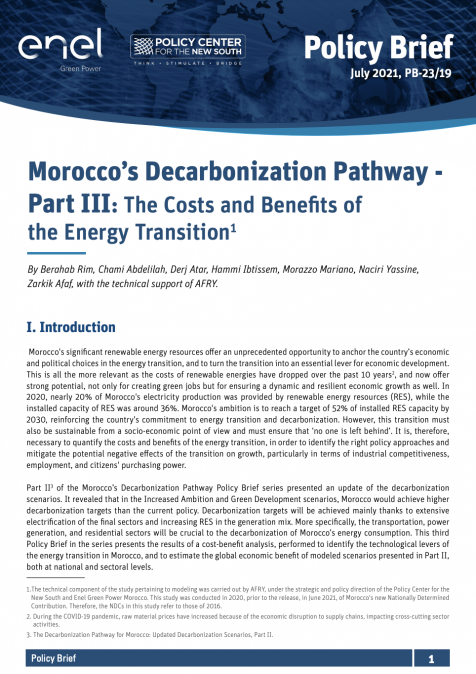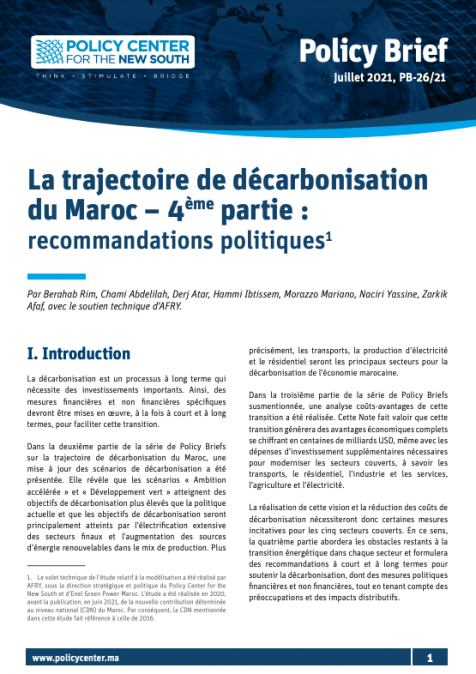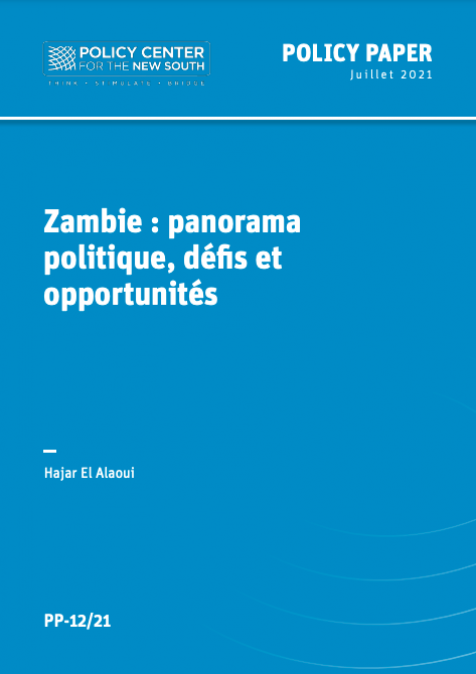In recent years, and in light of the mounting challenges associated with the effects of climate change on communities worldwide, discussions have ramped up on the necessity to crowd in private money to meet the sustainable development goals (SDGs) and mitigate environmental challenges to livelihoods. In this discussion, Rakan Aboneaaj, Research Associate at the Center for Global Development and member of the ADEL 2023 cohort, highlights the main stakes of the mobilization of private capital to that effect.
RELATED CONTENT
-
Hamza M'jahed & Rim BerahabOctober 01, 2021The climate crisis is a latent threat that has been brewing for several years. Its repercussions affect both individuals and economies. Since the Paris Agreement, progress has stalled in ...
-
September 17, 2021...
-
 AuthorsSeptember 8, 2021The report of the United Nations Intergovernmental Panel on Climate Change (IPCC), released at the beginning of August, left no room for doubt. According to its estimates, it will be necessary to accelerate the pace of global containment of carbon emissions if the expected increases in global average temperatures are to be kept below 2 or 1.5 degrees Celsius, with correspondingly less-dramatic climatic consequences. Even if emissions of greenhouse gases are reduced over the next few ...
AuthorsSeptember 8, 2021The report of the United Nations Intergovernmental Panel on Climate Change (IPCC), released at the beginning of August, left no room for doubt. According to its estimates, it will be necessary to accelerate the pace of global containment of carbon emissions if the expected increases in global average temperatures are to be kept below 2 or 1.5 degrees Celsius, with correspondingly less-dramatic climatic consequences. Even if emissions of greenhouse gases are reduced over the next few ... -
Uri Dadush & Afaf ZarkikAugust 13, 2021La Commission Européenne a adopté en Décembre 2019 le pacte vert pour l’Europe, nouvelle stratégie de croissance, visant à mettre l'Europe sur les rails de la transition vers une société ...
-
AuthorsChami AbdelilahDerj AtarHammi IbtissemMorazzo MarianoNaciri Yassinewith the technical support of AFRYJuly 29, 2021As decarbonization is a long-term process and requires significant investments, specific financial and non- financial measures will need to be implemented, both in the short and long term, to facilitate this transition. In Part II of Morocco’s decarbonization pathway Policy Brief series, an update of the decarbonization scenarios was presented. It revealed that the Increased Ambition and Green Development scenarios achieve higher decarbonization targets than current policy. It showe ...
-
AuthorsChami AbdelilahDerj AtarHammi IbtissemMorazzo MarianoNaciri Yassinewith the technical support of AFRYJuly 23, 2021La décarbonisation est un processus à long terme qui nécessite des investissements importants. Ainsi, des mesures financières et non financières spécifiques devront être mises en œuvre, à la fois à court et à long termes, pour faciliter cette transition. Dans la deuxième partie de la série de Policy Briefs sur la trajectoire de décarbonisation du Maroc, une mise à jour des scénarios de décarbonisation a été présentée. Elle révèle que les scénarios « Ambition accélérée » et « Dévelop ...
-
AuthorsChami AbdelilahDerj AtarHammi IbtissemMorazzo MarianoNaciri Yassinewith the technical support of AFRYJuly 19, 2021Morocco's significant renewable energy resources offer an unprecedented opportunity to anchor the country’s economic and political choices in the energy transition, and to turn the transition into an essential lever for economic development. This is all the more relevant as the costs of renewable energies have dropped over the past 10 years2, and now offer strong potential, not only for creating green jobs but for ensuring a dynamic and resilient economic growth as well. In 2020, ne ...
-
Afaf Zarkik & Francis PerrinJuly 16, 2021La contre-révolution énergétique de Donald Trump couronnée par son plan énergétique « America First », avait remis en cause l’essentiel du plan d’action pour le climat de son prédécesseur ...
-
 AuthorsJuly 16, 2021The BDA Currents: Where Diplomacy Meets Business, is the Brussels Diplomatic Academy’s annual report covering the wider geopolitical and other factors influencing and affecting the world of diplomacy, international relations and global business. The journal focuses on issues of topical interest around the centers of global power, influence and importance, including the continents of Europe and Africa, the Middle East, China, India & Asia, Russia and the Commonwealth of Independe ...
AuthorsJuly 16, 2021The BDA Currents: Where Diplomacy Meets Business, is the Brussels Diplomatic Academy’s annual report covering the wider geopolitical and other factors influencing and affecting the world of diplomacy, international relations and global business. The journal focuses on issues of topical interest around the centers of global power, influence and importance, including the continents of Europe and Africa, the Middle East, China, India & Asia, Russia and the Commonwealth of Independe ... -
AuthorsJuly 12, 2021Frappée de plein fouet par la crise sanitaire de la Covid-19, la République de Zambie, déjà fragilisée, fait face à de nombreux défis sur les plans politique, économique, social et climatique. Outre sa position géographique de pays enclavé, le croissant de l’Afrique australe se positionne comme l’une des premières victimes du réchauffement climatique sur le continent rendant vulnérable une partie de sa population souffrant d’insécurité alimentaire accrue. Par ailleurs, et à l’approc ...






